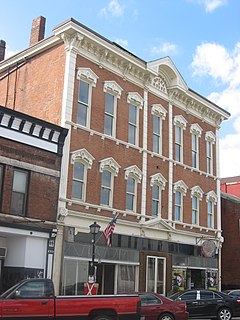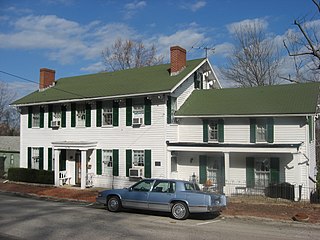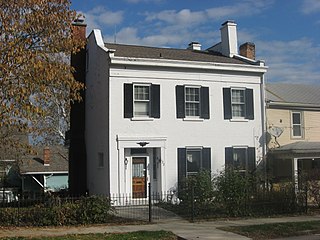
The Laughery Creek Bridge is a triple whipple truss bridge on the border of Dearborn County, Indiana, and Ohio County, Indiana. It crosses Laughery Creek. This bridge was built in 1878. The Wrought Iron Bridge Company, a prolific late 19th-century bridge company, constructed the bridge. The bridge is seated on stone abutments. The deck surface is not original and is currently concrete. The bridge, nearly 300 feet in length, is a single span pin connected triple intersection Whipple through truss, and is the only example in the world of this truss type. The name bridge's nickname, "Triple Whipple Bridge" is a play on words. The double-intersection Pratt, which was called the Whipple truss configuration, was a far more common variation of the standard Pratt configuration. Since the Laughery Creek Bridge's members have three intersections instead of two, this gives rise to the "Triple Whipple" name. This bridge was listed on the National Register of Historic Places in 1976.

Manchester Township is one of fourteen townships in Dearborn County, Indiana. As of the 2010 census, its population was 3,215 and it contained 1,233 housing units.

The First Presbyterian Church of Aurora, Indiana is a historic Presbyterian congregation and church located at Aurora, Dearborn County, Indiana. The original building completed in 1855 is still used, and is believed to have been designed by architect John R. Hamilton. It is a two-story, rectangular, Greek Revival style red brick building painted white. It measure approximately 45 feet wide by 75 feet deep and rests on a rough cut limestone foundation. It features a steeply tower consisting of a base, belfry, clock, and steeple.

Hamline Chapel, United Methodist Church is a historic Methodist church located at High and Vine Streets in Lawrenceburg, Dearborn County, Indiana. It was built about 1847, and is a one-story, gable front, Greek Revival style brick building on a raised basement. A rear addition was built about 1900 and two-story Sunday School and office addition in the 1950s. The church was renovated in 1979.

Moore's Hill United Methodist Church, also known as Methodist Episcopal Church, is a historic Methodist church located at 13476 Main Street in Moores Hill, Dearborn County, Indiana. It was built in 1871, and is a simple one-story, gable front, brick building with Greek Revival and Italianate style design elements. It rests on a limestone foundation and has four Doric order pilasters on the front facade.

St. John's Lutheran Church is a congregation of the Lutheran Church–Missouri Synod. located in Caesar Creek Township, Dearborn County, Indiana. Organized in 1843, the congregation has about 300 baptized members.

Aurora City Hall is a historic city hall located at Aurora, Dearborn County, Indiana. It was built in two sections in 1870 and 1887. The older section is a two-story, Italianate style brick and stone building purchased in 1882 to house the fire department. The 1887 section was built to house the city hall and is a two-story, Romanesque Revival style brick and stone building with a gable front. The buildings were connected about 1970.

Leive, Parks and Stapp Opera House, also known as the Grand Opera House, is a historic opera house located at Aurora, Dearborn County, Indiana. It was built in 1878, and is a three-story, Italianate style brick building. It measures 53 feet wide and 104 feet deep. The front facade features a cast iron storefront with pilasters with Corinthian order capitals.

Lewis Hurlbert Sr. House is a historic home located at Aurora, Dearborn County, Indiana. It was built in 1844, and is a two-story, five bay, frame dwelling with Italianate and Greek Revival style design elements. It has a double pile plan, sits on a cut limestone foundation, and side gable roof. It has a two-story addition built in the mid-19th century. Also on the property are the contributing stable, outhouse, and two sections of cat iron fencing.

Levi Stevens House, also known as the Stevens-Thatcher-Crosson House, is a historic home located at Aurora, Dearborn County, Indiana. It was built in 1849, and is a 2+1⁄2-story, three bay, Greek Revival style 2/3 I-house. It has an "L"-shaped plan, sits on a rough cut limestone foundation, and has a low side gable roof. It has a one-story rear kitchen addition.

Dearborn County Courthouse is a historic courthouse located at Lawrenceburg, Dearborn County, Indiana. It was built in 1870–71, and is a three-story, five bay, Greek Revival style building constructed of limestone. It features a three bay pedimented portico with four fluted columns with Corinthian order capitals.

Daniel S. Major House is a historic home located at Lawrenceburg, Dearborn County, Indiana. It was built between 1857 and 1860, and is a two-story, rectangular, Italianate style brick dwelling. It has an ashlar stone foundation, low hipped roof, polygonal bay windows, and a two-story service wing.

Vance-Tousey House is a historic home located at Lawrenceburg, Dearborn County, Indiana. It was built about 1818, and is a two-story, five bay, Late Georgian / Federal style brick and sandstone dwelling with a low hipped roof. The main block is flanked by 1+1⁄2-story wings. Flanking the main entrance are fluted Doric order engaged columns above which is a Palladian window. It was built by Samuel C. Vance, founder of the town of Lawrenceburg. It houses the Dearborn County Historical Society.

Veraestau is a historic home located in Center Township, Dearborn County, Indiana. It was built in 1838, and is a two-story, Greek Revival style brick and frame dwelling. It incorporates an earlier brick extension to the original 1810 log cabin that burned in 1838. A two-story addition was built in 1913, and a three-room brick addition to it in 1937. Also on the property are the contributing stable and carriage house (1937), Indian mound, family cemetery, and the remains of a kiln. The original house was built by Jesse Lynch Holman (1784-1842). Veraestau was also the birthplace of his son Congressman William S. Holman (1822-1897) and home of his son-in-law Allen Hamilton (1798–1864), who built the 1838 house.

George Street Bridge, also known as County Bridge No. 159, is a historic Whipple truss bridge located at Aurora, Dearborn County, Indiana. It was built by the Lomas Forge & Bridge Works in 1887. It traverses Hogan Creek and measures 199 feet, 4 inches, long. It is one of the oldest iron bridges in Indiana.

Downtown Aurora Historic District is a national historic district located at Aurora, Dearborn County, Indiana. The district encompasses 272 contributing buildings, 1 contributing site, and 3 contributing structures in the central business district of Aurora. The district developed between about 1830 and 1944, and includes notable examples of Italianate, Federal, and Greek Revival style architecture. Located in the district are the separately listed Aurora City Hall, Aurora Methodist Episcopal Church, Aurora Public Library, First Evangelical United Church of Christ, First Presbyterian Church, George Street Bridge, Hillforest, Lewis Hurlbert, Sr. House, Leive, Parks and Stapp Opera House, and George Sutton Medical Office. Other notable buildings include the T. and J.W. Gaff Distillery (1843), First National Bank (1924), I.O.O.F. Hall (1887), B&O Railroad Station (1911-1917), John Neff Building, Chamber Stevens & Co. Dry Goods Store, U.S. Post Office (1935), Star Milling Co. (1891), and St. John's Evangelical Lutheran Church (1874).

Downtown Lawrenceburg Historic District is a national historic district located at Lawrenceburg, Dearborn County, Indiana. The district encompasses 257 contributing buildings and 2 contributing objects in the central business district and surrounding residential sections of Lawrenceburg. The district developed between about 1815 and 1900, and includes notable examples of Late Victorian, Federal, and Greek Revival style architecture. Located in the district are the separately listed Dearborn County Courthouse and Hamline Chapel United Methodist Church. Other notable buildings include the Trade and Industrial Building (1881), Lawrenceburg Theater (1875), Jesse Hunt Hotel (1818), the birthplaces of James B. Eads and Louis Skidmore.

River View Cemetery is a historic rural cemetery located in Center Township, Dearborn County, Indiana. Designed by noted architect William Tinsley, the cemetery was established in 1869, and features curvilinear and contoured drive paths and radial burial arrangements. Notable contributing resources include the Soldier's Circle; entry gate, fencing, and signage; the cemetery chapel (1906); Romanesque Revival style well house (1889); and three mausoleums: the Yorm Mausoleum (1886), Stevens Mausoleum (1907), and McHenry Mausoleum (1877). Notable interments include Jesse Lynch Holman (1784-1842), Lonnie Mack (1941-2016), and William Steele Holman (1822-1897).

Dekalb County Home and Barn is a historic poor house and barn located at Garrett, DeKalb County, Indiana. The barn was built in 1908, and is a 3+1⁄2-story, "T"-shaped building. The first level is constructed of rubble stone, with frame upper stories.

Christopher Apple House, also known as the Apple Farm House, is a historic home located in Lawrence Township, Marion County, Indiana. It was built in 1859, and is a two-story, four bay Federal style brick dwelling with Greek Revival style design elements. It has a side gable roof and 1+1⁄2-story rear wing.
























